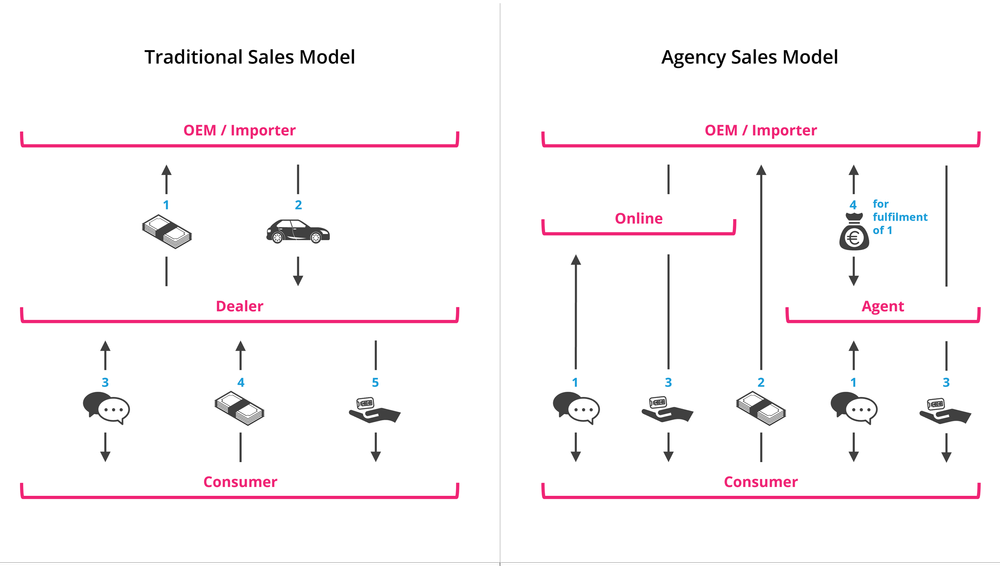WHOLESALE TO RETAIL TRANSFORMATION: PEOPLE FIRST
The automotive industry is transforming its approach to the market as manufacturers look for ways to reduce distribution costs, the expectations of customers change, and technology continually evolves. The growth of online sales and the need for transparent customer data to drive seamless services across their connected vehicles and franchised dealer networks has led some manufacturers to explore an ‘agency model’. In this article we consider the potential impact of this transformation on the manufacturer, their network, and – most importantly – the people that work in it.
From wholesale to retail
Aside from large fleet contracts, manufacturers currently sell their vehicles to a known group of customers, their franchised dealer networks. This is a wholesale arrangement.
There are variations in the agency model approach, but essentially it means the manufacturer sells directly to the customer, and their dealerships act as facilitators (or agents) who receive payment for the services they complete. This is a retail arrangement and is a fundamental sea change for the industry.
People at the heart of the strategy
The manufacturer is now responsible for maintaining a direct customer relationship, which supports online sales and is supported by connected vehicle services. However, it also requires transformation across the manufacturer and their sales network to create a more customer-focused approach, especially at a tactical level.
Whatever it is, the way you tell your story online can make all the difference.
This means the restructuring of key functions within the manufacturer and even the creation of new departments. New roles will be required and new skills will need to be developed within the current workforce, or resourced in, to help the manufacturer build capacity.
It would be tempting for manufacturers to concentrate on technology or process – which take time to plan and refine – but the best strategy in the world might be set for failure without having people ready and equipped to implement and drive the change. They also need to be given the time and tools to succeed.
Enabling and empowering employees to develop new skills and capabilities – and a mindset that aligns with the strategy – will heavily influence the outcome of any transformation.
Opportunities for dealers
The change at dealers will be just as transformational and will impact sales, aftersales and even used cars. The formal relationship between manufacturer and dealer will need to be set, based on the type of agency model being pursued. This, in turn, will set the business model of the dealership and its relationship with the customer. Although the dealer will need to adapt to this new model, it will potentially bring freedoms for their business to explore and exploit. They will need an appropriate skillset to achieve this.
All this is occurring during the introduction of new models, powertrains, in-car technologies and associated connected services. Although driven by the customer, the automotive industry evolution has the potential to be incredibly confusing for the majority, which could impact customer satisfaction and the bottom line.
Clear and consistent communications
Any approach must be collaborative between the manufacturer, their NSCs and in-market dealer networks. This requires clear communications between all stakeholders and partners, including a sensitive approach to contract and business model changes, actively addressing concerns and issues as they arise and supporting partners through the transition.
Ideally the strategy will start with the new customer journeys, their touchpoints and those responsible for managing those key interactions. From here roles, responsibilities and structures can be devised and planned. Current employee development can be identified, and recruitment and other methods of resourcing support can be planned and implemented.
Leadership must be visible and unified at the manufacturer, NSC and dealership. Communications must be consistent. Resource development must be lean and effective to allow people to source learning and support when they need it, without ‘removing’ them from delivering for the customer.
This is a singular opportunity to address the challenges to customer satisfaction that have evolved as the industry has over time. However, it will take a fundamentally new approach to not recreate similar issues within the new model.
For manufacturers, this is about recognising that the barometer of success will shift quickly from sales to customer experience, and that their people will be the vital component to achieving genuine progress and success.



